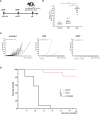Optimized dithranol-imiquimod-based transcutaneous immunization enables tumor rejection
- PMID: 37727790
- PMCID: PMC10505723
- DOI: 10.3389/fimmu.2023.1238861
Optimized dithranol-imiquimod-based transcutaneous immunization enables tumor rejection
Abstract
Introduction: Transcutaneous immunization (TCI) is a non-invasive vaccination method promoting strong cellular immune responses, crucial for the immunological rejection of cancer. Previously, we reported on the combined application of the TLR7 agonist imiquimod (IMQ) together with the anti-psoriatic drug dithranol as novel TCI platform DIVA (dithranol/IMQ based vaccination). In extension of this work, we further optimized DIVA in terms of drug dose, application pattern and established a new IMQ formulation.
Methods: C57BL/6 mice were treated on the ear skin with dithranol and IMQ-containing ointments together with ovalbumin-derived peptides. T cell responses were determined by flow cytometry and IFN-ɤ ELISpot assay, local skin inflammation was characterized by ear swelling.
Results: Applying the adjuvants on separate skin sites, a reduced number of specific CD8+ T cells with effector function was detectable, indicating that the local concurrence of adjuvants and peptide antigens is required for optimal vaccination. Likewise, changing the order of dithranol and IMQ resulted in an increased skin inflammatory reaction, but lower frequencies of antigen-specific CD8+ T cells indicating that dithranol is essential for superior T cell priming upon DIVA. Dispersing nanocrystalline IMQ in a spreadable formulation (IMI-Sol+) facilitated storage and application rendering comparable immune responses. DIVA applied one or two weeks after the first immunization resulted in a massive increase in antigen-specific T cells and up to a ten-fold increased memory response. Finally, in a prophylactic tumor setting, double but no single DIVA treatment enabled complete control of tumor growth, resulting in full tumor protection.
Discussion: Taken together, the described optimized transcutaneous vaccination method leads to the generation of a strong cellular immune response enabling the effective control of tumor growth and has the potential for clinical development as a novel non-invasive vaccination method for peptide-based cancer vaccines in humans.
Keywords: cytotoxic T lymphocytes (CTL); dithranol (anthralin); imiquimod (IMQ); trancutaneous immunization; tumor rejection.
Copyright © 2023 Hartmann, Bartneck, Pielenhofer, Meiser, Arnold-Schild, Klein, Stassen, Schild, Muth, Probst, Langguth, Grabbe and Radsak.
Conflict of interest statement
A-KH and MR are inventors of a patent application submitted by the UMC Mainz EP 18204287.9. The remaining authors declare that the research was conducted in the absence of any commercial or financial relationships that could be construed as a potential conflict of interest.
Figures





References
-
- World Health Organization . Global vaccine safety Blueprint 2.0 (GVSB2.0). 2021-2023.
Publication types
MeSH terms
Substances
LinkOut - more resources
Full Text Sources
Medical
Research Materials

